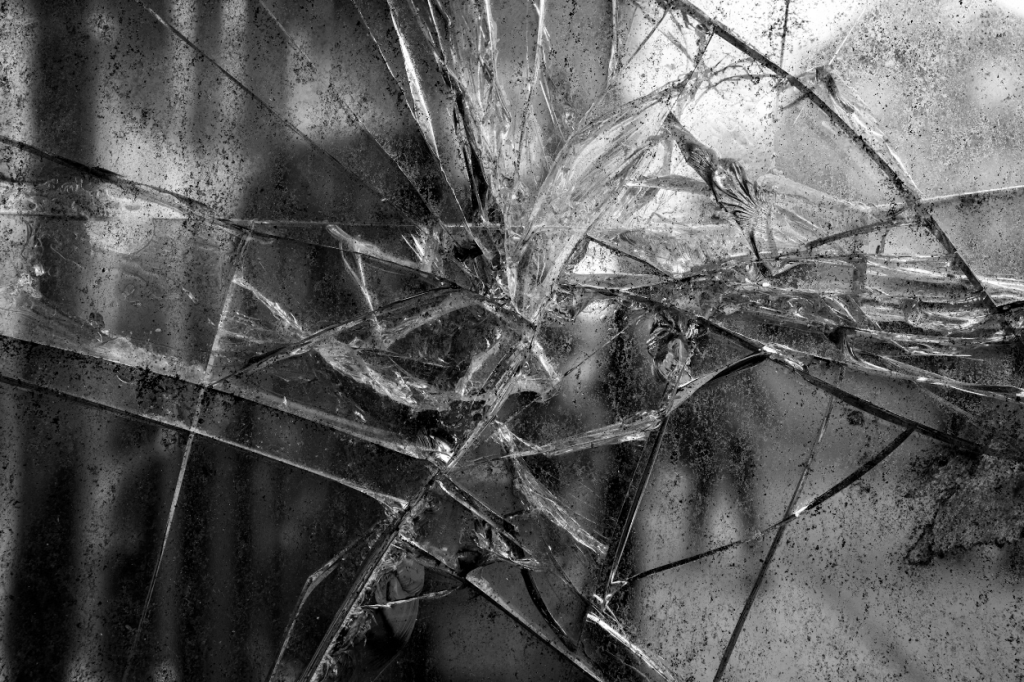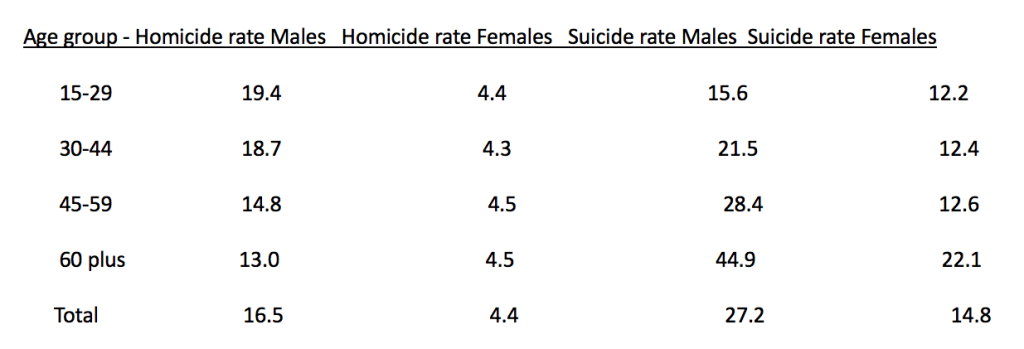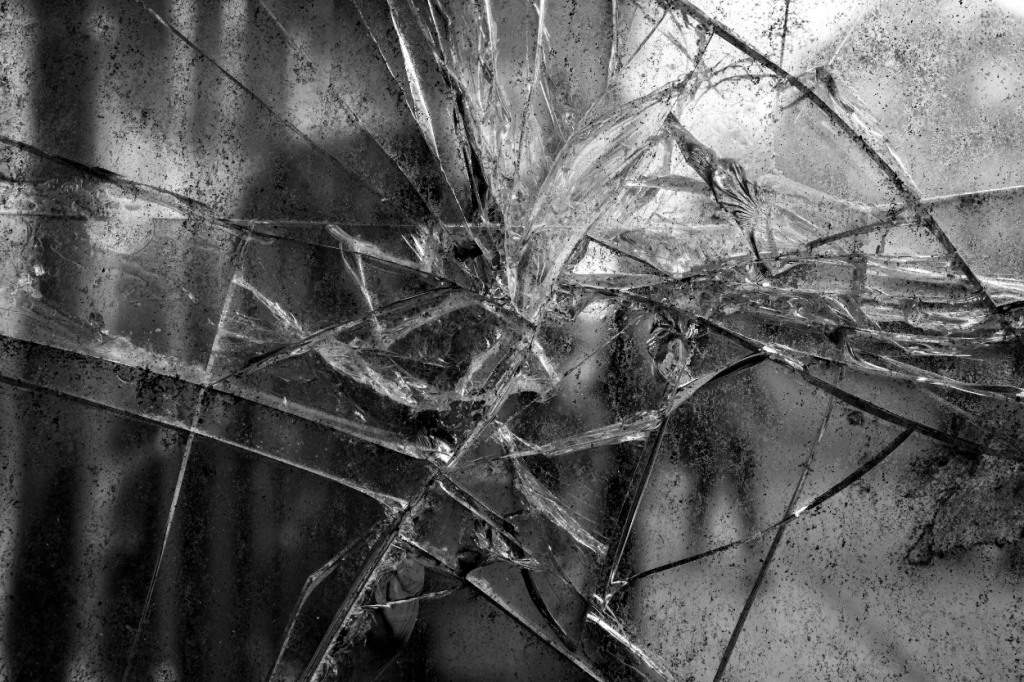
Part 3
In Part 1, I shared my challenges with depression, the fact that the suicide rate for males is so much higher than it is for females, and how these realties have impacted men and their families. In Part 2, I looked more deeply into the underlying causes and potential solutions to this world-wide problem. In Part 3, I will build on an evolutionary understanding and how it can help us address the major problems of male violence, directed inwards and outwards.
We don’t often think of suicide as a form of violence or depression as an underlying cause of violence, but they are intimately related. The World Health Organization (WHO) produced an in-depth analysis of violence and published the information under the title, “The World Report on Violence and Health.” The report is the result of 3 years of work, during which WHO drew on the knowledge of more than 160 experts from more than 70 countries.
The report detailed estimated global-related deaths as follows:

These numbers vary in different years and rates of violent deaths also vary according by country and within each country with different groups. But clearly violence from suicide accounts for nearly as many deaths as war-related violence and homicides combined. All forms of violence are tragic and many have come to believe that violence is simply a part of human nature. But this is not true.
Violence of all kinds can be understood and prevented.
“Violence thrives in the absence of democracy, respect for human rights and good governance,” said Nelson Mandela. We often talk about how a ‘culture of violence’ can take root. This is indeed true—as a South African who has lived through apartheid and is living through its aftermath, I have seen and experience it. No country, no city, no community is immune. But neither are we powerless against it.”
In order to understand and prevent violence, we must first accept the reality that males, on average, are more violent than females. We see this from the WHO report on violence cited above. Here are additional statistics on estimated global homicide and suicide rates by age group and gender:

At every age males die from homicide and suicide at rates much higher than females. It is also true that males perpetrate more violence that results in death than do females. Although biology is not destiny, we must accept that biology plays a significant role in the increased prevalence of male violence.
Richard V. Reeves is founder of the American Institute of Boys and Men and author of the book Of Boys and Men: Why The Modern Male Is Struggling, Why It Matters, and What to Do About It. In his chapter “Making Men: Nature and Nurture Matter,” he says,
“It is not helpful to deny or dismiss sex differences”
and quotes anthropologist Melvin Konner who said,
“I want my sons and daughters, my hundreds of students, or any young people, or anyone at all to miss the fact that there are differences between the sexes that are not shaped by culture but are more fundamental, rooted in evolution and biology.”
Reeves goes on to talk about the influence of the hormones in males and females.
“One result of the testosterone bath of male brains is a greater tendency toward physical aggression, not just in humans but in almost all primates and mammals. Human males are more physically aggressive in all cultures at all ages. Boys are five times more likely than girls to be frequently aggressive by the age of seventeen—seventeen months, that is. The gap widens until early adulthood before narrowing again. Worldwide, men commit over 95% of homicides and the overwhelming majority of violent acts of other kinds, including sexual assault.”
Male Violence is Not Inevitable
When we describe the biological realities that make mammalian males, including human mammals, more aggressive, some people conclude that male violence is inevitable and unchangeable. That is not true.
James Gilligan, M.D. has spent his life dealing with male violence. He is a world-renowned psychiatrist and the former director of the Center for the Study of Violence at Harvard Medical School. He is best known for his series of books entitled Violence, where he drew on more than 25 years of work in the American prison system to describe the motivation and causes behind violent behavior. When asked what drew him to work with violent offenders, he shared his personal story.
“I think the ultimate answer, as with most major life decisions that people make, goes back to my earliest childhood. I grew up in a family with a father who was quite violent toward my two brothers. He would really whack around. He would knock them across the room to the point where I was really scared he would accidentally kill one of them.
“Now, it’s true, the level of violence didn’t reach the extremes that I later became familiar with when I worked with prison inmates who were often the children of fathers or mothers who actually had killed a family member. My father didn’t go that far. He was never arrested, and nobody ever made a complaint of child abuse or anything. That was in the days before people even had a concept of child abuse. The whole concept of the battered child syndrome wasn’t articulated and expressed until around 1963 in the Journal of the American Medical Association. Before that, people didn’t even talk about child abuse.”
In his book, Violence: Our Deadly Epidemic and Its Causes, Dr. Gilligan connects his own families violence to societal violence.
“My father was caught in a cycle of generations of violence that played itself out in our family as it had, indeed, in the very land on which we were living, a land purchased with the blood of the natives whom we displaced.”
He goes on to describe the link between violence and growing up male.
“All this violence—against the native peoples of the land, against my brothers—was part of a larger pattern—that statistically, most legal violence is committed by men against other men. Violence is primarily men’s work; it is carried out more frequently against men, and is about the maintenance of manhood. To say that is not to minimize men’s violence against women; it is, rather, to take the first step toward understanding the etiology of violence, against both men and women.”
Males Are Violent Because Their Souls Have Been Violated
I have worked with violent men throughout my career as a psychotherapist specializing in men’s mental and emotional health. I have had similar experiences to those Dr. Gilligan describes when he first entered a prison.
“Looking at the gate leading into the Massachusetts prison you do not see inscribed over it Dante’s motto, ‘Abandon all hope ye who enter here,’ but it does not need to be, for most of those whom I see there had already abandoned all hope. To speak of these men as ‘the living dead’ is not a metaphor I have invented, but rather the most direct, literal, and least distorted way to summarize what these men have told me.”
In his book, Under Saturn’s Shadow: The Wounding and Healing of Men, Jungian analyst Dr. James Hollis says simply,
“Men’s lives are violent because their souls have been violated.”
He goes on to say, “Mass-murderers and serial killers have all suffered violent verbal and physical abuse. The frustrated postal employee or bank clerk who goes berserk has become commonplace on the six o’clock news. But that is only the tip of the iceberg. Soul murders occur all the time in the lives of men.”
The Moonshot For Mankind: Bringing Organizations Together For Good
My father suffered his own kind of soul murder when he was kept from doing the work he loved which I described in Part 1 of this series. My own work over the last fifty-plus years has been to heal the masculine soul. Three years ago I invited a group of colleagues to join me in what I called “a moonshot for mankind” to work together to heal the mental, emotional, and relational wounds that lead to violence.
On our website, MoonshotForMankind.org, you can learn about our efforts. We invite organizations who share our goals to join us. Here are a few of the organizations that have joined the movement:
Shana James, ManAlive Podcasts. Says Shana,
“For 15 years I have coached more than a thousand leaders, CEOs, authors, speakers and people with big visions who step into more powerful leadership, start and grow businesses, create more effective teams, increase their impact, get promoted, find love, rekindle spark, create a legacy, and become more personally inspired and fulfilled.”
Frederick Marx, Warrior Films. Says Frederick,
“I aim to provide some of the tools to enable people everywhere to reach for their own human transformation and to lend a hand in support of men everywhere. Warrior Films inspires needed social change by telling compelling stories highlighting transformational solutions.”
Lisa Hickey, The Good Men Project, Says Lisa,
“The Good Men Project is one of the largest worldwide conversations about what it means to be a good man in the twenty-first century. We are trying to create big, sweeping, societal changes—overturn stereotypes, eliminate racism, sexism, and homophobia, and be a positive force for things like education reform and improving the environment.”
ManTherapy.org: Man Therapy is an evidence-based, decades-long, multidisciplinary effort to break though stigma, improve help-seeking behavior and reduce male suicide. And they’ve got the stats to back it up. Learn more here.
MenLiving.org: MenLiving delivers programs and experiences to help create a world of healthy, intentional, connected men who can heal and thrive. Learn more here.
Men and Boys Compassion Initiative (MBCI) is an international movement to help men and boys cultivate their compassionate selves. This also requires the cultivation of courage and wisdom to heal the male crisis of disconnection.
The post Homecoming: An Evolutionary Approach for Healing Depression and Preventing Suicide appeared first on MenAlive.
